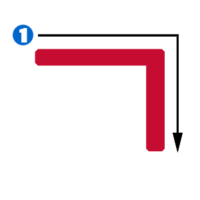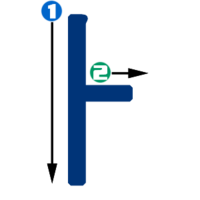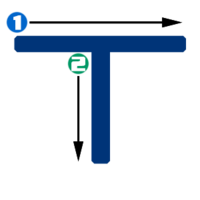Difference between revisions of "Hangeul step 2/nl"
DigitalSoju (Talk | contribs) |
Marc Wentink (Talk | contribs) |
||
| (4 intermediate revisions by 2 users not shown) | |||
| Line 7: | Line 7: | ||
|} | |} | ||
| − | == | + | ==Inleiding== |
| − | + | Omdat je medeklinkers niet kunt uitspreken zonder een klinker hebben we besloten om je telkens eerst een klinker te leren en die dan te koppelen aan een medeklinker. Sommige bestanden zijn in een loop gezet, dus die moet je zelf stopzetten. | |
| − | In | + | In deze les leer je: |
| − | * | + | *Medeklinkers: [[ㄱ]], [[ㄴ]], [[ㅁ]], [[ㄷ]], [[ㅇ]] |
| − | * | + | *Klinkers: [[ㅏ]], [[ㅜ]], [[ㅗ]], [[ㅣ]] |
| Line 19: | Line 19: | ||
|Consonant = ㄱ | |Consonant = ㄱ | ||
|Cons image = ㄱ.jpg | |Cons image = ㄱ.jpg | ||
| − | |Cons text = | + | |Cons text = Deze spreek je aan het begin van een woord uit als een klank die tussen de G als in het woord ''goal'' en de K in zit. Als hij echter tussen klinkers staat, wordt hij stemhebbend als een /g/. Zie voor de volledige informatie over deze letter [[ㄱ]]. |
|Vowel = ㅏ | |Vowel = ㅏ | ||
|Vowel image = ㅏ.jpg | |Vowel image = ㅏ.jpg | ||
| − | |Vowel text = | + | |Vowel text = Deze spreek je uit als de a klank in het woord: appel. Het neigt dus meer naar een kòrte a klank. Zie voor de volledige informatie over deze letter [[ㅏ]]. |
| − | |Vowel audio description1 = | + | |Vowel audio description1 = Man |
|Vowel audio1 = <flashmp3>a H.mp3|leftbg=003478|rightbg=c60c30|lefticon=ffffff|righticon=ffffff</flashmp3> | |Vowel audio1 = <flashmp3>a H.mp3|leftbg=003478|rightbg=c60c30|lefticon=ffffff|righticon=ffffff</flashmp3> | ||
| − | |Vowel audio description2 = | + | |Vowel audio description2 = Vrouw |
|Vowel audio2 = <flashmp3>a M.mp3|leftbg=003478|rightbg=c60c30|lefticon=ffffff|righticon=ffffff</flashmp3> | |Vowel audio2 = <flashmp3>a M.mp3|leftbg=003478|rightbg=c60c30|lefticon=ffffff|righticon=ffffff</flashmp3> | ||
}} | }} | ||
| Line 31: | Line 31: | ||
{| class="wikitable" style="text-align:center; margin-left: auto; margin-right: auto; font-size:300%;" | {| class="wikitable" style="text-align:center; margin-left: auto; margin-right: auto; font-size:300%;" | ||
|-style="font-size:70%" | |-style="font-size:70%" | ||
| − | !colspan="2"| | + | !colspan="2"|Oefening |
|- | |- | ||
| 가 | | 가 | ||
| Line 43: | Line 43: | ||
|Consonant = ㄴ | |Consonant = ㄴ | ||
|Cons image = ㄴ.jpg | |Cons image = ㄴ.jpg | ||
| − | |Cons text = | + | |Cons text = Deze letter heeft dezelfde klank als de Nederlandse N. Zie voor de volledige informatie over deze letter [[ㄴ]]. |
|Vowel = ㅜ | |Vowel = ㅜ | ||
|Vowel image = ㅜ.jpg | |Vowel image = ㅜ.jpg | ||
| − | |Vowel text = | + | |Vowel text = Deze letter klinkt als "oe", zoals in 'k'''oe'''' of 't'''oe'''n'. Zie voor de volledige informatie over deze letter [[ㅜ]]. |
| − | |Vowel audio description1 = | + | |Vowel audio description1 = Man |
|Vowel audio1 = <flashmp3>u H.mp3|leftbg=003478|rightbg=c60c30|lefticon=ffffff|righticon=ffffff</flashmp3> | |Vowel audio1 = <flashmp3>u H.mp3|leftbg=003478|rightbg=c60c30|lefticon=ffffff|righticon=ffffff</flashmp3> | ||
| − | |Vowel audio description2 = | + | |Vowel audio description2 = Vrouw |
|Vowel audio2 = <flashmp3>u M.mp3|leftbg=003478|rightbg=c60c30|lefticon=ffffff|righticon=ffffff</flashmp3> | |Vowel audio2 = <flashmp3>u M.mp3|leftbg=003478|rightbg=c60c30|lefticon=ffffff|righticon=ffffff</flashmp3> | ||
}} | }} | ||
| Line 55: | Line 55: | ||
{| class="wikitable" style="text-align:center; margin-left: auto; margin-right: auto; font-size:300%;" | {| class="wikitable" style="text-align:center; margin-left: auto; margin-right: auto; font-size:300%;" | ||
|-style="font-size:70%" | |-style="font-size:70%" | ||
| − | !colspan="2"| | + | !colspan="2"|Oefening |
|- | |- | ||
| 누 | | 누 | ||
| Line 73: | Line 73: | ||
|Consonant = ㅁ | |Consonant = ㅁ | ||
|Cons image = ㅁ.jpg | |Cons image = ㅁ.jpg | ||
| − | |Cons text = | + | |Cons text = Deze letter heeft dezelfde klank als de Nederlandse M. Zie voor de volledige informatie over deze letter [[ㅁ]]. |
|Vowel = ㅗ | |Vowel = ㅗ | ||
|Vowel image = ㅗ.jpg | |Vowel image = ㅗ.jpg | ||
| − | |Vowel text = | + | |Vowel text = Lange o-klank zoals in boom Zie voor de volledige informatie over deze letter [[ㅗ]]. |
| − | |Vowel audio description1 = | + | |Vowel audio description1 = Man |
|Vowel audio1 = <flashmp3>o H.mp3|leftbg=003478|rightbg=c60c30|lefticon=ffffff|righticon=ffffff</flashmp3> | |Vowel audio1 = <flashmp3>o H.mp3|leftbg=003478|rightbg=c60c30|lefticon=ffffff|righticon=ffffff</flashmp3> | ||
| − | |Vowel audio description2 = | + | |Vowel audio description2 = Vrouw |
|Vowel audio2 = <flashmp3>o M.mp3|leftbg=003478|rightbg=c60c30|lefticon=ffffff|righticon=ffffff</flashmp3> | |Vowel audio2 = <flashmp3>o M.mp3|leftbg=003478|rightbg=c60c30|lefticon=ffffff|righticon=ffffff</flashmp3> | ||
}} | }} | ||
| Line 85: | Line 85: | ||
{| class="wikitable" style="text-align:center; margin-left: auto; margin-right: auto; font-size:300%;" | {| class="wikitable" style="text-align:center; margin-left: auto; margin-right: auto; font-size:300%;" | ||
|-style="font-size:70%" | |-style="font-size:70%" | ||
| − | !colspan="2"| | + | !colspan="2"|Oefening |
|- | |- | ||
| 모 | | 모 | ||
| Line 108: | Line 108: | ||
|Consonant = ㄷ | |Consonant = ㄷ | ||
|Cons image = ㄷ.jpg | |Cons image = ㄷ.jpg | ||
| − | |Cons text = | + | |Cons text = Deze spreek je aan het begin van een woord uit als een klank die tussen de T en de D in zit. Als hij echter tussen klinkers staat, wordt hij stemhebbend als een /d/. Zie voor de volledige informatie over deze letter [[ㄷ]]. |
|Vowel = ㅣ | |Vowel = ㅣ | ||
|Vowel image = ㅣ.jpg | |Vowel image = ㅣ.jpg | ||
| − | |Vowel text = | + | |Vowel text = Deze letter klinkt als de 'i' in 'z'''ie''''. Zie voor de volledige informatie over deze letter [[ㅣ]]. |
| − | |Vowel audio description1 = | + | |Vowel audio description1 = Man |
|Vowel audio1 = <flashmp3>i H.mp3|leftbg=003478|rightbg=c60c30|lefticon=ffffff|righticon=ffffff</flashmp3> | |Vowel audio1 = <flashmp3>i H.mp3|leftbg=003478|rightbg=c60c30|lefticon=ffffff|righticon=ffffff</flashmp3> | ||
| − | |Vowel audio description2 = | + | |Vowel audio description2 = Vrouw |
|Vowel audio2 = <flashmp3>i M.mp3|leftbg=003478|rightbg=c60c30|lefticon=ffffff|righticon=ffffff</flashmp3> | |Vowel audio2 = <flashmp3>i M.mp3|leftbg=003478|rightbg=c60c30|lefticon=ffffff|righticon=ffffff</flashmp3> | ||
}} | }} | ||
| Line 120: | Line 120: | ||
{| class="wikitable" style="text-align:center; margin-left: auto; margin-right: auto; font-size:300%;" | {| class="wikitable" style="text-align:center; margin-left: auto; margin-right: auto; font-size:300%;" | ||
|-style="font-size:70%" | |-style="font-size:70%" | ||
| − | !colspan="2"| | + | !colspan="2"|Oefening |
|- | |- | ||
| 디 | | 디 | ||
| Line 146: | Line 146: | ||
{{Hangeul intro table extra | {{Hangeul intro table extra | ||
| − | |char = ㅇ ( | + | |char = ㅇ (Medeklinker) |
|Image = ㅇ.jpg | |Image = ㅇ.jpg | ||
| − | |Text = ㅇ | + | |Text = De ㅇ als eerste letter in een lettergreep vertegenwoordigt geen klank. Hij dient dan enkel als plaatsaanduider omdat <u>klinkers niet los geschreven kunnen worden</u>. Als ㅇ echter in de eindpositie (als ondermedeklinker) staat, klinkt hij als een "ng", zoals in 'zi'''ng'''' of 'koni'''ng'''' ([[IPA]]: ŋ ), maar de eindpositieklanken worden pas besproken in [[Hangeul_step_5|stap 5]] van deze les. Zie hem voorlopig als een plaatsaanduider van een medeklinker in lettergrepen waarin alleen een klinker wordt uitgesproken. Zie voor de volledige informatie over deze letter [[ㅇ]]. <!--Insert picture--> |
|Bgcolor = {{Kred}} | |Bgcolor = {{Kred}} | ||
|Audio description1 = | |Audio description1 = | ||
| Line 158: | Line 158: | ||
{| class="wikitable" style="text-align:center; margin-left: auto; margin-right: auto; font-size:300%;" | {| class="wikitable" style="text-align:center; margin-left: auto; margin-right: auto; font-size:300%;" | ||
|-style="font-size:70%" | |-style="font-size:70%" | ||
| − | !colspan="2"| | + | !colspan="2"|Oefening |
|- | |- | ||
| 아 | | 아 | ||
| Line 174: | Line 174: | ||
|} | |} | ||
| − | == | + | ==Echte voorbeelden== |
{| class="wikitable" style="text-align:center; margin-left: auto; margin-right: auto;" | {| class="wikitable" style="text-align:center; margin-left: auto; margin-right: auto;" | ||
|- | |- | ||
| − | ! | + | ! Woord !! Audio |
|- | |- | ||
| − | | 가구 ( | + | | 가구 (meubels) |
| <flashmp3>gagu H.mp3, gagu M.mp3|leftbg=003478|rightbg=c60c30|lefticon=ffffff|righticon=ffffff|loop=yes</flashmp3> | | <flashmp3>gagu H.mp3, gagu M.mp3|leftbg=003478|rightbg=c60c30|lefticon=ffffff|righticon=ffffff|loop=yes</flashmp3> | ||
|- | |- | ||
| − | | 가나다 ( | + | | 가나다 (Koreaans alfabet, oftewel abc) |
| <flashmp3>ganada H.mp3, ganada M.mp3|leftbg=003478|rightbg=c60c30|lefticon=ffffff|righticon=ffffff|loop=yes</flashmp3> | | <flashmp3>ganada H.mp3, ganada M.mp3|leftbg=003478|rightbg=c60c30|lefticon=ffffff|righticon=ffffff|loop=yes</flashmp3> | ||
|- | |- | ||
| − | | 가다 ( | + | | 가다 (gaan) |
| <flashmp3>gada H.mp3, gada M.mp3|leftbg=003478|rightbg=c60c30|lefticon=ffffff|righticon=ffffff|loop=yes</flashmp3> | | <flashmp3>gada H.mp3, gada M.mp3|leftbg=003478|rightbg=c60c30|lefticon=ffffff|righticon=ffffff|loop=yes</flashmp3> | ||
|- | |- | ||
| − | | 가두다 ( | + | | 가두다 (insluiten) |
| <flashmp3>gaduda H.mp3, gaduda M.mp3|leftbg=003478|rightbg=c60c30|lefticon=ffffff|righticon=ffffff|loop=yes</flashmp3> | | <flashmp3>gaduda H.mp3, gaduda M.mp3|leftbg=003478|rightbg=c60c30|lefticon=ffffff|righticon=ffffff|loop=yes</flashmp3> | ||
|- | |- | ||
| − | | 고구마 ( | + | | 고구마 (zoete aardappel) |
| <flashmp3>goguma H.mp3, goguma M.mp3|leftbg=003478|rightbg=c60c30|lefticon=ffffff|righticon=ffffff|loop=yes</flashmp3> | | <flashmp3>goguma H.mp3, goguma M.mp3|leftbg=003478|rightbg=c60c30|lefticon=ffffff|righticon=ffffff|loop=yes</flashmp3> | ||
|- | |- | ||
| − | | 고기 ( | + | | 고기 (vlees) |
| <flashmp3>gogi H.mp3, gogi M.mp3|leftbg=003478|rightbg=c60c30|lefticon=ffffff|righticon=ffffff|loop=yes</flashmp3> | | <flashmp3>gogi H.mp3, gogi M.mp3|leftbg=003478|rightbg=c60c30|lefticon=ffffff|righticon=ffffff|loop=yes</flashmp3> | ||
|- | |- | ||
| − | | 고모 ( | + | | 고모 (zus van je vader) <!-- ook wel 'tante' genoemd? ... --> |
| <flashmp3>gomo H.mp3, gomo M.mp3|leftbg=003478|rightbg=c60c30|lefticon=ffffff|righticon=ffffff|loop=yes</flashmp3> | | <flashmp3>gomo H.mp3, gomo M.mp3|leftbg=003478|rightbg=c60c30|lefticon=ffffff|righticon=ffffff|loop=yes</flashmp3> | ||
|- | |- | ||
| − | | 구두 ( | + | | 구두 (nette schoenen) |
| <flashmp3>gudu H.mp3, gudu M.mp3|leftbg=003478|rightbg=c60c30|lefticon=ffffff|righticon=ffffff|loop=yes</flashmp3> | | <flashmp3>gudu H.mp3, gudu M.mp3|leftbg=003478|rightbg=c60c30|lefticon=ffffff|righticon=ffffff|loop=yes</flashmp3> | ||
|- | |- | ||
| − | | 기도 ( | + | | 기도 (gebed) |
| <flashmp3>gido H.mp3, gido M.mp3|leftbg=003478|rightbg=c60c30|lefticon=ffffff|righticon=ffffff|loop=yes</flashmp3> | | <flashmp3>gido H.mp3, gido M.mp3|leftbg=003478|rightbg=c60c30|lefticon=ffffff|righticon=ffffff|loop=yes</flashmp3> | ||
|- | |- | ||
| − | | 나가다 ( | + | | 나가다 (naar buiten gaan) |
| <flashmp3>nagada H.mp3, nagada M.mp3|leftbg=003478|rightbg=c60c30|lefticon=ffffff|righticon=ffffff|loop=yes</flashmp3> | | <flashmp3>nagada H.mp3, nagada M.mp3|leftbg=003478|rightbg=c60c30|lefticon=ffffff|righticon=ffffff|loop=yes</flashmp3> | ||
|- | |- | ||
| − | | 나누다 ( | + | | 나누다 (verdelen) |
| <flashmp3>Nanuda H.mp3, Nanuda M.mp3|leftbg=003478|rightbg=c60c30|lefticon=ffffff|righticon=ffffff|loop=yes</flashmp3> | | <flashmp3>Nanuda H.mp3, Nanuda M.mp3|leftbg=003478|rightbg=c60c30|lefticon=ffffff|righticon=ffffff|loop=yes</flashmp3> | ||
|- | |- | ||
| − | | 나무 ( | + | | 나무 (boom) |
| <flashmp3>Namu H.mp3, Namu M.mp3|leftbg=003478|rightbg=c60c30|lefticon=ffffff|righticon=ffffff|loop=yes</flashmp3> | | <flashmp3>Namu H.mp3, Namu M.mp3|leftbg=003478|rightbg=c60c30|lefticon=ffffff|righticon=ffffff|loop=yes</flashmp3> | ||
|- | |- | ||
| − | | 나오다 ( | + | | 나오다 (naar buiten komen) |
| <flashmp3>Naoda H.mp3, Naoda M.mp3|leftbg=003478|rightbg=c60c30|lefticon=ffffff|righticon=ffffff|loop=yes</flashmp3> | | <flashmp3>Naoda H.mp3, Naoda M.mp3|leftbg=003478|rightbg=c60c30|lefticon=ffffff|righticon=ffffff|loop=yes</flashmp3> | ||
|- | |- | ||
| − | | 나이 ( | + | | 나이 (leeftijd) |
| <flashmp3>nai H.mp3, nai M.mp3|leftbg=003478|rightbg=c60c30|lefticon=ffffff|righticon=ffffff|loop=yes</flashmp3> | | <flashmp3>nai H.mp3, nai M.mp3|leftbg=003478|rightbg=c60c30|lefticon=ffffff|righticon=ffffff|loop=yes</flashmp3> | ||
|- | |- | ||
| − | | 누가 ( | + | | 누가 (wie) |
| <flashmp3>nuga H.mp3, nuga M.mp3|leftbg=003478|rightbg=c60c30|lefticon=ffffff|righticon=ffffff|loop=yes</flashmp3> | | <flashmp3>nuga H.mp3, nuga M.mp3|leftbg=003478|rightbg=c60c30|lefticon=ffffff|righticon=ffffff|loop=yes</flashmp3> | ||
|- | |- | ||
| − | | 누구 ( | + | | 누구 (wie) |
| <flashmp3>nugu H.mp3, nugu M.mp3|leftbg=003478|rightbg=c60c30|lefticon=ffffff|righticon=ffffff|loop=yes</flashmp3> | | <flashmp3>nugu H.mp3, nugu M.mp3|leftbg=003478|rightbg=c60c30|lefticon=ffffff|righticon=ffffff|loop=yes</flashmp3> | ||
|- | |- | ||
| − | | 누나 ( | + | | 누나 (oudere zus van een man) |
| <flashmp3>nuna H.mp3, nuna M.mp3|leftbg=003478|rightbg=c60c30|lefticon=ffffff|righticon=ffffff|loop=yes</flashmp3> | | <flashmp3>nuna H.mp3, nuna M.mp3|leftbg=003478|rightbg=c60c30|lefticon=ffffff|righticon=ffffff|loop=yes</flashmp3> | ||
|- | |- | ||
| − | | 다가가다 ( | + | | 다가가다 (iemand naderen) |
| <flashmp3>dagagada H.mp3, dagagada M.mp3|leftbg=003478|rightbg=c60c30|lefticon=ffffff|righticon=ffffff|loop=yes</flashmp3> | | <flashmp3>dagagada H.mp3, dagagada M.mp3|leftbg=003478|rightbg=c60c30|lefticon=ffffff|righticon=ffffff|loop=yes</flashmp3> | ||
|- | |- | ||
| − | | 다니다 ( | + | | 다니다 (gaan naar (werk, school etc.)) |
| <flashmp3>danida H.mp3, danida M.mp3|leftbg=003478|rightbg=c60c30|lefticon=ffffff|righticon=ffffff|loop=yes</flashmp3> | | <flashmp3>danida H.mp3, danida M.mp3|leftbg=003478|rightbg=c60c30|lefticon=ffffff|righticon=ffffff|loop=yes</flashmp3> | ||
|- | |- | ||
| − | | 도구 (instrument, | + | | 도구 (instrument, gereedschap) |
| <flashmp3>dogu H.mp3, dogu M.mp3|leftbg=003478|rightbg=c60c30|lefticon=ffffff|righticon=ffffff|loop=yes</flashmp3> | | <flashmp3>dogu H.mp3, dogu M.mp3|leftbg=003478|rightbg=c60c30|lefticon=ffffff|righticon=ffffff|loop=yes</flashmp3> | ||
|- | |- | ||
| − | | 마다 ( | + | | 마다 (elke, iedere) |
| <flashmp3>mada H.mp3, mada M.mp3|leftbg=003478|rightbg=c60c30|lefticon=ffffff|righticon=ffffff|loop=yes</flashmp3> | | <flashmp3>mada H.mp3, mada M.mp3|leftbg=003478|rightbg=c60c30|lefticon=ffffff|righticon=ffffff|loop=yes</flashmp3> | ||
|- | |- | ||
| − | | 마디 ( | + | | 마디 (gewricht, knoop) |
| <flashmp3>madi H.mp3, madi M.mp3|leftbg=003478|rightbg=c60c30|lefticon=ffffff|righticon=ffffff|loop=yes</flashmp3> | | <flashmp3>madi H.mp3, madi M.mp3|leftbg=003478|rightbg=c60c30|lefticon=ffffff|righticon=ffffff|loop=yes</flashmp3> | ||
|- | |- | ||
| − | | 모기 ( | + | | 모기 (mug) |
| <flashmp3>mogi H.mp3, mogi M.mp3|leftbg=003478|rightbg=c60c30|lefticon=ffffff|righticon=ffffff|loop=yes</flashmp3> | | <flashmp3>mogi H.mp3, mogi M.mp3|leftbg=003478|rightbg=c60c30|lefticon=ffffff|righticon=ffffff|loop=yes</flashmp3> | ||
|- | |- | ||
| Line 251: | Line 251: | ||
| <flashmp3>agi H.mp3, agi M.mp3|leftbg=003478|rightbg=c60c30|lefticon=ffffff|righticon=ffffff|loop=yes</flashmp3> | | <flashmp3>agi H.mp3, agi M.mp3|leftbg=003478|rightbg=c60c30|lefticon=ffffff|righticon=ffffff|loop=yes</flashmp3> | ||
|- | |- | ||
| − | | 아마도 ( | + | | 아마도 (misschien, wellicht) |
| <flashmp3>amado H.mp3, amado M.mp3|leftbg=003478|rightbg=c60c30|lefticon=ffffff|righticon=ffffff|loop=yes</flashmp3> | | <flashmp3>amado H.mp3, amado M.mp3|leftbg=003478|rightbg=c60c30|lefticon=ffffff|righticon=ffffff|loop=yes</flashmp3> | ||
|- | |- | ||
| − | | 아우 (man | + | | 아우 (jongere broer van een man-wordt niet meer gebruikt) |
| <flashmp3>au H.mp3, au M.mp3|leftbg=003478|rightbg=c60c30|lefticon=ffffff|righticon=ffffff|loop=yes</flashmp3> | | <flashmp3>au H.mp3, au M.mp3|leftbg=003478|rightbg=c60c30|lefticon=ffffff|righticon=ffffff|loop=yes</flashmp3> | ||
|- | |- | ||
| − | | 아이 ( | + | | 아이 (kind) |
| <flashmp3>ai H.mp3, ai M.mp3|leftbg=003478|rightbg=c60c30|lefticon=ffffff|righticon=ffffff|loop=yes</flashmp3> | | <flashmp3>ai H.mp3, ai M.mp3|leftbg=003478|rightbg=c60c30|lefticon=ffffff|righticon=ffffff|loop=yes</flashmp3> | ||
|- | |- | ||
| − | | 오다 ( | + | | 오다 (komen) |
| <flashmp3>oda H.mp3, oda M.mp3|leftbg=003478|rightbg=c60c30|lefticon=ffffff|righticon=ffffff|loop=yes</flashmp3> | | <flashmp3>oda H.mp3, oda M.mp3|leftbg=003478|rightbg=c60c30|lefticon=ffffff|righticon=ffffff|loop=yes</flashmp3> | ||
|- | |- | ||
| − | | 오이 ( | + | | 오이 (komkommer) |
| <flashmp3>oi H.mp3, oi M.mp3|leftbg=003478|rightbg=c60c30|lefticon=ffffff|righticon=ffffff|loop=yes</flashmp3> | | <flashmp3>oi H.mp3, oi M.mp3|leftbg=003478|rightbg=c60c30|lefticon=ffffff|righticon=ffffff|loop=yes</flashmp3> | ||
|- | |- | ||
| − | | 이기다 ( | + | | 이기다 (winnen) |
| <flashmp3>igida H.mp3, igida M.mp3|leftbg=003478|rightbg=c60c30|lefticon=ffffff|righticon=ffffff|loop=yes</flashmp3> | | <flashmp3>igida H.mp3, igida M.mp3|leftbg=003478|rightbg=c60c30|lefticon=ffffff|righticon=ffffff|loop=yes</flashmp3> | ||
|- | |- | ||
| − | | 이모 ( | + | | 이모 (zus van je moeder) |
| <flashmp3>imo H.mp3, imo M.mp3|leftbg=003478|rightbg=c60c30|lefticon=ffffff|righticon=ffffff|loop=yes</flashmp3> | | <flashmp3>imo H.mp3, imo M.mp3|leftbg=003478|rightbg=c60c30|lefticon=ffffff|righticon=ffffff|loop=yes</flashmp3> | ||
|} | |} | ||
| − | == | + | ==Schrijven== |
| − | + | Karakters worden in een vaste volgorde geschreven. Koreaanse letters schrijf je van links naar rechts en van boven naar beneden. | |
{| border=0 style="text-align:center; margin-left: auto; margin-right: auto;" | {| border=0 style="text-align:center; margin-left: auto; margin-right: auto;" | ||
|- | |- | ||
| − | |[[File:ㄱ stroke order.png|200px]]<br>ㄱ | + | |[[File:ㄱ stroke order.png|200px]]<br>ㄱ wordt zo geschreven in combinatie met een horizontale klinker zoals ㅗ of ㅜ. |
| − | |[[File:ㄱ stroke order2.png|200px]]<br>ㄱ | + | |[[File:ㄱ stroke order2.png|200px]]<br>ㄱ wordt zo geschreven in combinatie met een verticale klinker zoals ㅏ of ㅣ. |
| − | |[[File:ㄴ stroke order.png|200px]]<br>ㄴ | + | |[[File:ㄴ stroke order.png|200px]]<br>ㄴ wordt ''ongeveer'' als een L geschreven. |
|- | |- | ||
| − | |[[File:ㅁ stroke order.png|200px]]<br> | + | |[[File:ㅁ stroke order.png|200px]]<br>Laat je niet misleiden door het lettertype, ㅁ wordt als een blokje geschreven. |
| − | |[[File:ㄷ stroke order.png|200px]]<br>ㄷ | + | |[[File:ㄷ stroke order.png|200px]]<br>ㄷ wordt met 2 strepen geschreven, schrijf hem niet als een 'C.' |
| − | |[[File:ㅇ stroke order.png|200px]]<br>ㅇ | + | |[[File:ㅇ stroke order.png|200px]]<br>ㅇ wordt als een Romeinse 'O' geschreven. |
|- | |- | ||
| − | |[[File:ㅏ stroke order.png|200px]]<br>ㅏ | + | |[[File:ㅏ stroke order.png|200px]]<br>ㅏ wordt met 2 strepen geschreven. |
|[[File:ㅜ stroke order.png|200px]]<br> | |[[File:ㅜ stroke order.png|200px]]<br> | ||
|[[File:ㅗ stroke order.png|200px]]<br> | |[[File:ㅗ stroke order.png|200px]]<br> | ||
|- | |- | ||
| | | | ||
| − | |[[File:ㅣ stroke order.png|200px]]<br> | + | |[[File:ㅣ stroke order.png|200px]]<br>Een rechte streep van boven naar beneden. |
| | | | ||
|} | |} | ||
==Video== | ==Video== | ||
| − | + | Bekijk deze les op talktomeinkorean.com's youtube-kanaal: | |
*[http://www.youtube.com/watch?v=AqFGHMxWtYk&feature=player_embedded How to read and write Hangeul (Part 1)] | *[http://www.youtube.com/watch?v=AqFGHMxWtYk&feature=player_embedded How to read and write Hangeul (Part 1)] | ||
Latest revision as of 09:06, 10 May 2016
|
|
|
| Help · Cheat Sheet · Community portal |

|

|
Contents
Inleiding
Omdat je medeklinkers niet kunt uitspreken zonder een klinker hebben we besloten om je telkens eerst een klinker te leren en die dan te koppelen aan een medeklinker. Sommige bestanden zijn in een loop gezet, dus die moet je zelf stopzetten.
In deze les leer je:
|
| ||||||||||
|
Deze spreek je uit als de a klank in het woord: appel. Het neigt dus meer naar een kòrte a klank. Zie voor de volledige informatie over deze letter ㅏ.
|
Deze spreek je aan het begin van een woord uit als een klank die tussen de G als in het woord goal en de K in zit. Als hij echter tussen klinkers staat, wordt hij stemhebbend als een /g/. Zie voor de volledige informatie over deze letter ㄱ. | ||||||||||
| Oefening | |
|---|---|
| 가 | |
|
| ||||||||||
|
Deze letter klinkt als "oe", zoals in 'koe' of 'toen'. Zie voor de volledige informatie over deze letter ㅜ.
|
Deze letter heeft dezelfde klank als de Nederlandse N. Zie voor de volledige informatie over deze letter ㄴ. | ||||||||||
| Oefening | |
|---|---|
| 누 | |
| 나 | |
| 구 | |
|
| ||||||||||
|
Lange o-klank zoals in boom Zie voor de volledige informatie over deze letter ㅗ.
|
Deze letter heeft dezelfde klank als de Nederlandse M. Zie voor de volledige informatie over deze letter ㅁ. | ||||||||||
| Oefening | |
|---|---|
| 모 | |
| 마 | |
| 무 | |
| 고 | |
| 노 | |
|
| ||||||||||
|
Deze letter klinkt als de 'i' in 'zie'. Zie voor de volledige informatie over deze letter ㅣ.
|
Deze spreek je aan het begin van een woord uit als een klank die tussen de T en de D in zit. Als hij echter tussen klinkers staat, wordt hij stemhebbend als een /d/. Zie voor de volledige informatie over deze letter ㄷ. | ||||||||||
| Oefening | |
|---|---|
| 디 | |
| 다 | |
| 두 | |
| 도 | |
| 기 | |
| 니 | |
| 미 | |
| ||||
|
De ㅇ als eerste letter in een lettergreep vertegenwoordigt geen klank. Hij dient dan enkel als plaatsaanduider omdat klinkers niet los geschreven kunnen worden. Als ㅇ echter in de eindpositie (als ondermedeklinker) staat, klinkt hij als een "ng", zoals in 'zing' of 'koning' (IPA: ŋ ), maar de eindpositieklanken worden pas besproken in stap 5 van deze les. Zie hem voorlopig als een plaatsaanduider van een medeklinker in lettergrepen waarin alleen een klinker wordt uitgesproken. Zie voor de volledige informatie over deze letter ㅇ. | ||||
| Oefening | |
|---|---|
| 아 | |
| 우 | |
| 오 | |
| 이 | |
Echte voorbeelden
| Woord | Audio |
|---|---|
| 가구 (meubels) | |
| 가나다 (Koreaans alfabet, oftewel abc) | |
| 가다 (gaan) | |
| 가두다 (insluiten) | |
| 고구마 (zoete aardappel) | |
| 고기 (vlees) | |
| 고모 (zus van je vader) | |
| 구두 (nette schoenen) | |
| 기도 (gebed) | |
| 나가다 (naar buiten gaan) | |
| 나누다 (verdelen) | |
| 나무 (boom) | |
| 나오다 (naar buiten komen) | |
| 나이 (leeftijd) | |
| 누가 (wie) | |
| 누구 (wie) | |
| 누나 (oudere zus van een man) | |
| 다가가다 (iemand naderen) | |
| 다니다 (gaan naar (werk, school etc.)) | |
| 도구 (instrument, gereedschap) | |
| 마다 (elke, iedere) | |
| 마디 (gewricht, knoop) | |
| 모기 (mug) | |
| 아기 (baby) | |
| 아마도 (misschien, wellicht) | |
| 아우 (jongere broer van een man-wordt niet meer gebruikt) | |
| 아이 (kind) | |
| 오다 (komen) | |
| 오이 (komkommer) | |
| 이기다 (winnen) | |
| 이모 (zus van je moeder) |
Schrijven
Karakters worden in een vaste volgorde geschreven. Koreaanse letters schrijf je van links naar rechts en van boven naar beneden.
Video
Bekijk deze les op talktomeinkorean.com's youtube-kanaal:

|

|


















